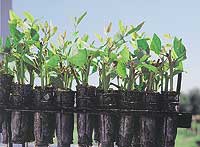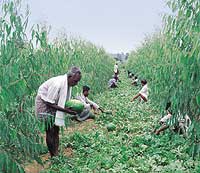|
|
|
|
|
|
|
|
|
|
|
|
|
|
|
|
|
|
|

|
|
|
|
|
|
|
|
|
|
|
|
|
|
|
|
|
|
|
At the heart
of this comprehensive greening project is ITC’s state-of-art research centre,
consistently striving for productivity improvement of several tree species in order to
give attractive land-use alternatives to traditional farmers |
|
These strategic
initiatives will, on one hand, make procurement of industrial timber exclusively from
sustainable sources a reality within 10 years and on the other hand, benefit 1.2 million
people through incremental employment. Additionally, it helps forest conservation by
reducing pressure on public forests. |
|
|
|
|
and wasteland
owners. So far 86 high-yielding, fast-growing and disease-resistant
‘Bhadrachalam’ clones have |
|
|
|

|
|
been produced
on a commercial scale with productivity that is 6-9 times that of the normal seedlings.
Included in these are 23 site-specific clones adapted to problematic alkaline and saline
soils. In the pipeline are research projects on casuarina, subabul, rain-fed bamboo and
sustainable agro-forestry models. |
|
Apart from the
obvious benefits of increasing the forest cover, this effort also directly contributes to
in-situ moisture conservation, groundwater recharge and significant reduction in top-soil
losses due to wind and water erosion. With poor households having access to their own
woody biomass under ITC’s social forestry programme, they can meet most of their
fuelwood requirements in-house through loppings and toppings, thus further reducing |
|
 |
|
pressure on
public forests. As a result of the leaf-litter from multi-species plantations and the
promotion of leguminous inter-crops, depleted soils are constantly enriched. Soon this
will lead to a decline in fertiliser and pesticide consumption, thus reducing the
pollution of groundwater sources by such chemicals. |
|
| |
|
|
|
|

|
| Inter-cropping on plantations provides
assured income to farmers during the gestation period of these plantations. |
|
|
| Social & Farm Forestry - at a glance |
| |
Milestones
Commencement
of initiative: Year 1998
• Area developed: 16,000 hectares
• Saplings planted: 35 million
• Number of beneficiaries through
additional employment:
16,000
people
|
|
|
|
| a |
| |
Agenda
for
then next decade
• Area to be developed: 100,000 hectares
• Saplings to be planted: 600 million
• Potential beneficiaries through
additional employment:
1.2 million people
|
|
|
|
|
|
|
|
|
|
|
|
|